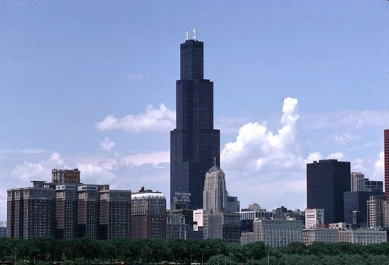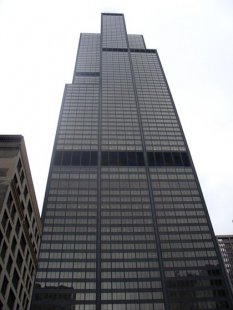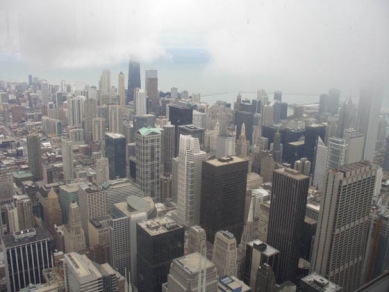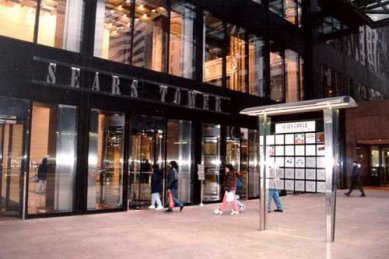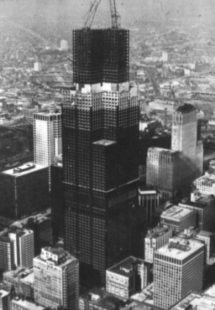
Sears Tower

"Graham and Khan pulled us out of the prosaic boxes of milk and cookie type characteristic of so many other buildings, whose expression is still the same, whether they are forty, sixty or eighty stories high... The Sears Tower clearly asserts itself with its volumes of lightweight character despite its height, similar to the skyscrapers built in the twenties of our century." Paul Gapp (1980)
The Sears Tower and the older John Hancock Center brought a new range of supertall architecture to Chicago, a city long proud of its technical innovations. Bruce Graham and Fazlur Khan, partners at SOM responsible for the design of both Chicago buildings, were commissioned by Sears, Roebuck and Company, a revolutionary retail company selling traditional valued wool, to create a headquarters uniting the functions of its mammoth operations in one object.
To ensure spacious ground floors for Sears employees and smaller upper rentable floors, the building was designed in parts of 50, 66, 90, and 110 stories. The essence of Khan's lightweight, yet extremely rigid, structure is simple: it consists of nine megamodules (75 square feet) connected into one. Only two of the modules reach a total height of 443 meters. The effects of wind and gravity are distributed over a larger mass of the building. The tubes work independently, taking only part of the load.
Although there are many ways structural economy can be achieved, Sears is probably the most intriguing solution to the visual problems posed by the skyscrapers of modernism with its simplicity. The tower, draped in dark aluminum and glass and ending in uneven heights, moves somewhere between the monotonous rectangles of Mies's pattern and the charming pointed shapes of early skyscrapers.
Louis Sullivan repeatedly stated that "the building is an act," which encompasses both moral and aesthetic significance. Similarly, Graham described the Sears Tower as "an instrument ... satisfying the needs, activities, and goals of the urban man." However, the Sears Tower is not entirely perfect, as might be suggested by the above characterization. In rooms glued around the inhospitable central space, workers are troubled by the effects of the wind. An employee on the 77th floor said: "On very windy days the building noticeably leans... the corner columns creak and groan... and my window panes flap and vibrate so disturbingly that I leave my office." Windows break so often that The Wall Street Journal dedicated an article to these events on November 2, 1988, which gave rise to an absurd myth when one of the secretaries heard that a man was blown out of a window by the wind and returned back in.
In 1988, Sears moved most of its employees to the suburbs of Chicago. An unsuccessful attempt to sell the building resulted in a renovation that alleviated the wind issues in the 46 floors cleared for new offices.
Falcons and hawks, effortlessly gliding on the wind currents, observe their prey from a perch on the 66th floor. The corpses of small birds and bats regularly fall in the same spot, unable to distinguish between the sky and the shiny facade, flying straight to their doom. The order of nature or the ruin of civilization? Skyscrapers can be assessed from many different perspectives. If human beings intend to live in harmony with these commercial trophies, then the Sears Tower is a harsh lesson in limitation. If bigger is better - or at least not bad - then the Sears Tower is great.
The Sears Tower and the older John Hancock Center brought a new range of supertall architecture to Chicago, a city long proud of its technical innovations. Bruce Graham and Fazlur Khan, partners at SOM responsible for the design of both Chicago buildings, were commissioned by Sears, Roebuck and Company, a revolutionary retail company selling traditional valued wool, to create a headquarters uniting the functions of its mammoth operations in one object.
To ensure spacious ground floors for Sears employees and smaller upper rentable floors, the building was designed in parts of 50, 66, 90, and 110 stories. The essence of Khan's lightweight, yet extremely rigid, structure is simple: it consists of nine megamodules (75 square feet) connected into one. Only two of the modules reach a total height of 443 meters. The effects of wind and gravity are distributed over a larger mass of the building. The tubes work independently, taking only part of the load.
Although there are many ways structural economy can be achieved, Sears is probably the most intriguing solution to the visual problems posed by the skyscrapers of modernism with its simplicity. The tower, draped in dark aluminum and glass and ending in uneven heights, moves somewhere between the monotonous rectangles of Mies's pattern and the charming pointed shapes of early skyscrapers.
Louis Sullivan repeatedly stated that "the building is an act," which encompasses both moral and aesthetic significance. Similarly, Graham described the Sears Tower as "an instrument ... satisfying the needs, activities, and goals of the urban man." However, the Sears Tower is not entirely perfect, as might be suggested by the above characterization. In rooms glued around the inhospitable central space, workers are troubled by the effects of the wind. An employee on the 77th floor said: "On very windy days the building noticeably leans... the corner columns creak and groan... and my window panes flap and vibrate so disturbingly that I leave my office." Windows break so often that The Wall Street Journal dedicated an article to these events on November 2, 1988, which gave rise to an absurd myth when one of the secretaries heard that a man was blown out of a window by the wind and returned back in.
In 1988, Sears moved most of its employees to the suburbs of Chicago. An unsuccessful attempt to sell the building resulted in a renovation that alleviated the wind issues in the 46 floors cleared for new offices.
Falcons and hawks, effortlessly gliding on the wind currents, observe their prey from a perch on the 66th floor. The corpses of small birds and bats regularly fall in the same spot, unable to distinguish between the sky and the shiny facade, flying straight to their doom. The order of nature or the ruin of civilization? Skyscrapers can be assessed from many different perspectives. If human beings intend to live in harmony with these commercial trophies, then the Sears Tower is a harsh lesson in limitation. If bigger is better - or at least not bad - then the Sears Tower is great.
The English translation is powered by AI tool. Switch to Czech to view the original text source.
0 comments
add comment


